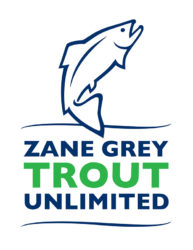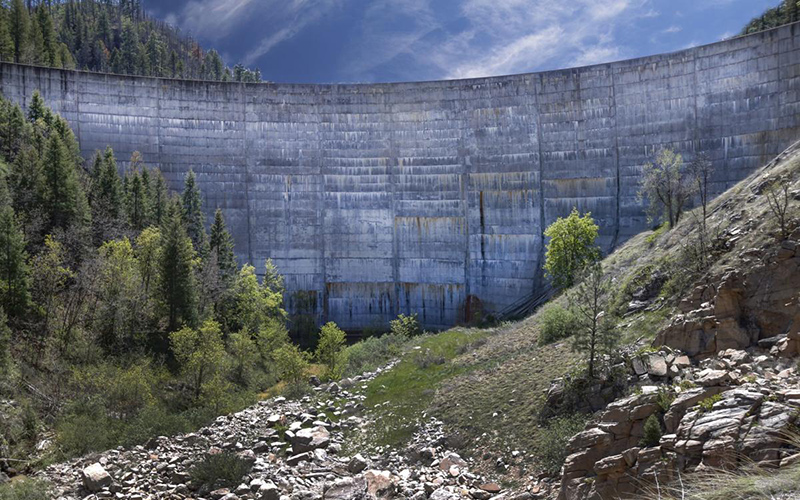I don’t believe in letting some weather forecaster run your life. So when Tom Osterday said he could take me out in his little boat and prove to me that the Blue Ridge Reservoir fishery had risen from the dead and dry, I said sure.
Granted, the weather forecast called for 40-mile-an-hour gusts by sometime in the mid-afternoon. But we planned to meet at 8 a.m., get on the lake, catch a couple of the 10,000 freshly stocked trout and make it to some cozy spot for lunch.
A perfect plan. What could go wrong?
I figured I’d be safe and sound in the hands of Osterday, who spent 35 years helping IBM run the world. He jetted all over everywhere, one of the big-brained guys who has all the angles figured. Come time to retire, he found his little slice of heaven on the C.C. Cragin Reservoir — which holds Payson’s water future in the steep, winding contours of a 200-foot-deep, 15,000-acre-foot lake.
“Historically, that lake is famous for big fish in the spring and good fishing in the fall,” said Scott Rogers, Game and Fish Region II aquatic wildlife program manager.
The deep, narrow lake retains enough water to carry the fish through the winter, leading to big fish in the spring. Moreover, the lake usually has lots of food for the freshly stocked trout — leading to some big fish come fall. The steep shoreline makes it tough to fish the lake without a boat, which reduces angler pressure.
Fishing slows down in June and July when the water warms up, algae blooms near the surface and the trout go deep, said Rogers.
Still, that’s perfect for folks like Osterday, with his own little aluminum boat.
Better yet, Game and Fish hooked a grant to completely transform the steep, narrow, little dirt metaphor for a boat ramp. The Coconino National Forest blasted away a rock wall and paved a wide ramp down into the lake, with lots of extra parking.
All well and good.
However, the lake’s had some problems.
For starters, two years ago Game and Fish found itself with a fish shortage in its hatcheries. So fishery managers skipped stocking the lightly used Blue Ridge for a season.
Then it got worse: Enter the drought.
Every year, the Salt River Project pumps most of the water out of Blue Ridge — officially known as C.C. Cragin. The water flows down a pipeline jointly owned by SRP and Payson, then gushes into the East Verde River at Washington Park. Payson’s 3,000-acre share of the water will instead go into a pipeline running along Houston Mesa Road, starting this week or next.
Last year, the 64,000-acre watershed got almost no snow. They never turned on the pumps. Heck, you couldn’t even use the fancy new boat ramp. So Game and Fish never stocked the lake.
So after two years without stocking and one year of going almost dry, you couldn’t catch trout in Blue Ridge with dynamite. This caused Osterday all kinds of anguish. But he quietly lobbied Game and Fish to jump-start the fishery now that a bountiful winter has filled the lake to the brim.
So Game and Fish has now plunked 10,000 rainbows into the reservoir.
Now, the fish have some challenges. They have to share food with an infestation of illegally stocked green sunfish.
“They’re like cockroaches,” said Rogers. “They just fill space and consume resources – not good for a trout fishery. Trying to mechanically remove all of those little buggers is an arms war you’re never going to win.”
Still, the 10,000 stocked trout should have a good old time, with the lake up, plenty of submerged vegetation and a bloom of both insect larvae and daphnia — little shrimp-like crustaceans better known as water fleas.
They might even bump into the occasional surviving native Sonoran sucker.
“We’d love to also put some native fish in there — maybe Gila trout,” said Rogers. But right now, Game and Fish is still learning to grow the finicky native trout in large quantities.
So once Tom found out Game and Fish was going to stock the reservoir in May, he started emailing me — promising a string of fish or at least a soothing day on the water. We met on schedule, bumped down the five-mile dirt road to the fancy new boat ramp and launched without incident.
And so began the adventure.
Don’t get me wrong: The fishing was great. They were hitting our lures like crazy, mostly in the vicinity of the boat ramp. Turns out, stocked trout don’t generally move too far from where they first plop into the water – although this tendency is better documented in streams than in lakes. We quickly pulled in six trout — although two of mine managed to spit out the hook once they got a good look at the boat.
But I have a certain genius for not knowing when to stop — just ask my wife about my puns. So I suggested we putter on up to the dam. Last time I saw it, the lake was half empty. Tom agreed enthusiastically, eager to get his beloved reservoir as much good press as possible.
So he turned off the electric trolling motor and yanked the pull rope of the 10 hp Mercury outboard. Nothing. Not even a good gagging/coughing sound, which is what I can normally coax out of an outboard. Remind me to tell you sometime about my years as a boat owner with young boys and a skeptical wife. Many of those trips ended with me breast-stroking back to shore with the bow rope clenched between my teeth.
“No worries,” said Osterday, sunnily. “The trolling motor will get us there.”
So off we went, puttering along, alarming the canvasback ducks and great blue herons — while attracting the professional attention of the circling turkey vultures. We covered all manner of topics as the clouds scudded across the sky and the wind began to gust. We agreed IBM should have seen Microsoft coming. But big organizations have a hard time recognizing when everything has changed — kind of like people in a little boat when the wind starts gusting.
When a second effort to start the outboard proved unsuccessful, I seized the oars, cast back to an affectionate recollection of my days as a Boy Scout camp counselor on Lake Emerson, dolling out the rowing merit badge.
We reached the dam without incident, marveling at the pileup of logs against the curving surface.
“Got what you need?”asked Osterday, a note of anxiety creeping into his voice.
“Absolutely,” I said.
So we turned about. On the way to the dam, I’d been rowing into the wind. But now the wind shifted. So we were still rowing into the wind, which made the skiff skitter like a waterbug going sideways.
That’s about when the trolling motor ran out of juice.
So we labored back toward the safety of the boat ramp, bullied by the wind — the oarlock squeaking like a teenager in a horror movie with every pull.
Osterday insisted on taking over at the oars just as my blisters got started.
“Should we put in to shore and wait for the wind to die down?” I asked.
“Nope. Supposed to get worse.”
“Ah well. Still a beautiful day,” I said.
“It is that,” said Tom.
“At least everything that can break has broken,” I joked.
At my age, you’d think I’d know better than to say dumb stuff like that.
So after about five more minutes of manly rowing, the bracket for the oarlock snapped off. So we each grabbed an oar and pretended it was a canoe paddle.
In this fashion, we made it back to the boat ramp, zigzagging across the lake with the wind, laughing out loud.
Safe back on the ramp, Osterday kept apologizing.
But that made no sense at all: I had a stringer of fish, a card full of photos, the breezy memory of a day on the lake and hadn’t drowned. Sounds like the perfect day to me.
by Peter Aleshire
Consulting Publications Editor
Payson Roundup
May 24, 2019
Contact the writer at paleshire@payson.com

